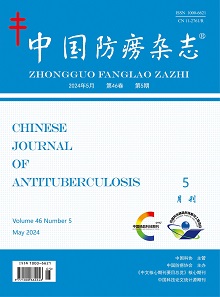Objective: To investigate the incidence, immune intervention value, and influencing factors of peripheral blood CD4+T lymphocytopenia in HIV-negative pulmonary tuberculosis (PTB) patients. Methods: The clinical data of 213 cases with HIV-negative PTB in Anhui Chest Hospital from December 2020 to July 2021 were analyzed, retrospectively. According to the CD4+T lymphocytes counts, 213 cases were divided into CD4+T lymphopenia group (count <410 cells/μl) and control group (count ≥410 cells/μl). The patients with CD4+T lymphopenia were divided into the immune intervention group and non-intervention group according to whether they received immune intervention. Demographic characteristics (gender, age, occupation, and education level), smoking, drinking, number of symptoms, treatment classifications, comorbid diseases, drug resistance, imaging, and laboratory test results were collected. Efficacy analysis between groups was compared using the Chi-square test. Multivariate logistic regression analysis was used after filtrating by univariate analysis to explore the influencing factors of peripheral blood CD4+T lymphocytopenia in HIV-negative PTB patients. Results: The incidence of CD4+T lymphopenia was 28.6% (61/213). The efficacy analysis showed that after 2-4 months of treatment, the negative rate of sputum smear in the immunological intervention group was 93.9%, higher than 75.0% in the non-intervention group (χ2=4.320, P<0.05). After 5-7 months of treatment, the absorption rate of lesions in the immunological intervention group was 51.5%, which was higher than 25.0% in the non-intervention group (χ2=4.462,P<0.05). Univariate analysis showed that in the CD4+T lymphopenia group, male, age ≥60 years, farming, illiterate culture, number of symptoms ≥4, complicated with extrapulmonary tuberculosis, involving 4-6 lung fields, pulmonary cavity, hemoglobin <110 g/L, platelet <125×109/L, albumin <35 g/L, CD8+T lymphocyte count <190/μl (77.0%, 44.3%, 36.1%, 26.2%, 36.1%, 34.4%, 77.0%, 55.7%, 45.9%, 18.0%, 68.9%, 29.5%) were significantly higher than that of control group (60.5%, 11.2%, 19.7%, 10.5%, 19.7%, 21.1%, 38.2%, 40.8%, 25.7%, 5.3%, 44.7%, 7.9%), the differences were statistically significant (χ2 values were 5.242, 29.060, 10.095, 13.650, 6.290, 4.165, 26.342, 3.929, 8.274, 8.738, 10.137, and 16.805, respectively, all P values <0.05). Multivariate logistic regression analysis showed that age ≥60 years old, lesion involvement of 4-6 lung fields, platelet <125×109/L, CD8+T lymphocytes count <190 cells/μl (OR=4.816,95%CI:1.650-14.052; OR=3.669,95%CI:1.548-8.696; OR=3.753,95%CI:1.069-13.173; OR=3.908,95%CI:1.394-10.954) were the risk factors of CD4+T lymphocytopenia. Conclusion: HIV-negative pulmonary tuberculosis patients were prone to a decrease in CD4+T lymphocytes, and immune intervention therapy had positive significance for improving the efficacy of this population. Old age, a wide range of lesions involved, thrombocytopenia, and CD8+T lymphocytopenia were the independent risk factors for CD4+T lymphocytopenia in HIV-negative PTB patients.

 Wechat
Wechat